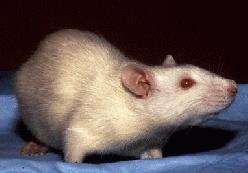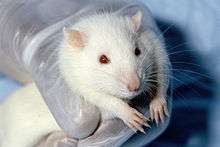Open field (animal test)
Developed by Calvin S. Hall, the open field test (OFT) is an experiment used to assay general locomotor activity levels and anxiety in rodents in scientific research and willingness to explore in rodents.[1][2][3] However, the extent to which behavior in the open field measures anxiety is controversial.
Concept
Animals such as rats and mice display a natural aversion to brightly lit areas. They also have a drive to explore a perceived threatening stimulus. The result of these two conflicting drives is anxiety. Decreased anxiety leads to increased exploratory behaviour. Increased anxiety will result in less locomotor motion and preference for the edges of the field.[4]
Experimental design

The open field is an arena with walls to prevent escape. Commonly, the field is marked with a grid and square crossings. The center of the field is marked with a different color to differentiate from the other squares. In the modern open field apparatus, infrared beams or video cameras with associated software[5] can be used to automate the assessment process.

Behavioral patterns measured in the open field test include:
- Line crossing – Frequency with which the rodent crossed a grid line with all four paws
- Center square entries – Frequency with which rodent entered center square with all four paws
- Center square duration – Duration of time spent in central square
- Rearing – Frequency with which the rodent stood on their hind legs in the field. This behavior shows increased exploratory behaviour.
- Stretch attend postures – Frequency with which rodent demonstrated forward elongation of the head and shoulders followed by retraction to the original position. High frequency indicates high levels of anxiety.
- Defecation and urination – The frequency of defecation and urination is controversial. Some scientists argue that increase in defecation shows increased anxiety. Other scientists disagree and state that defecation and urination show signs of emotionality but cannot be assumed to be anxiety[6]
The relation between the OFT and other tests of exploratory activity (elevated plus maze and emergence) have been analyzed in two mouse strains.[7] Changes in these measures are often used to assess the sedative or stimulant effects of pharmacological agents.
Newer attempts have been made to analyse the OFT by quantifying the animal's moment-by-moment developmental dynamics. A recent study was able to show that mouse exploratory behavior consists of sequences of repeated motion: iterative processes that increase in extent and complexity, whose presumed function is a systematic active management of input acquired during the exploration of a novel environment.[8]
Criticisms
The assumption that the OFT is based on conflict has been heavily criticized. Critics point out that when measuring anxiety each choice should have both positives and negative outcomes. This leads to more dependable observations which the OFT does not present.
In a modified OFT, animals would go to the center of the field if there were objects that the animal could explore. This shows that the standard OFT might not provide enough drive for exploration.
When the test was first developed, it was pharmacologically validated through the use of benzodiazepines, a common anxiety medication. Newer drugs such as as 5-HT-1A partial agonist and SSRIs which have also been proven to treat anxiety show inconsistent results with the OFT.[4]
Due to the idiopathic nature of anxiety, animal models have flaws that cannot be controlled. Because of this it is better to do the OFT in conjuncture with other tests such as the elevated plus maze and light-dark box test.[9]
Different results can be obtained depending on the strain of the animal. Different equipment and grid lines may cause different results.[10]
See also
- Animal models of depression
- Forced swim test (FST)
- Elevated plus maze
- Hole-board test
- Tail suspension test (TST)
References
- ↑ Denenberg, Victor H. (July 1969). "Open-field Behavior in the Rat: What Does it Mean?". Annals of the New York Academy of Sciences. 159 (Experimental Approaches to the Study of Emotional Behavior): 852–859. doi:10.1111/j.1749-6632.1969.tb12983.x.
- ↑ Hall, CS; Ballachey EL (1932). "A study of the rat's behavior in a field: a contribution to method in comparative psychology.". University of California Publications in Psychology. 6: 1–12.
- ↑ Stanford, SC (2007). "The Open Field Test: Reinventing the Wheel". Journal of Psychopharmacology. 21 (2): 134–4. doi:10.1177/0269881107073199.
- 1 2 Ennaceur, A (2013). "Tests of unconditioned anxiety — Pitfalls and disappointments". Physiology and Behaviour. 135: 55–71. doi:10.1016/j.physbeh.2014.05.032.
- ↑ Samson, Andre L.; Ju, Lining; Ah Kim, Hyun; Zhang, Shenpeng R.; Lee, Jessica A. A.; Sturgeon, Sharelle A.; Sobey, Christopher G.; Jackson, Shaun P.; Schoenwaelder, Simone M. (2015-01-01). "MouseMove: an open source program for semi-automated analysis of movement and cognitive testing in rodents". Scientific Reports. 5: 16171. doi:10.1038/srep16171. ISSN 2045-2322. PMC 4632026
 . PMID 26530459.
. PMID 26530459. - ↑ "The Open Field Test" (PDF). The University of Nairobi. The University of Nairobi. Retrieved 15 April 2016.
- ↑ Lalonde, R; Strazielle C (2008). "Relations between open-field, elevated plus-maze, and emergence tests as displayed by C57/BL6J and BALB/c mice.". Journal of Neuroscience Methods. 171 (1): 48–52. doi:10.1016/j.jneumeth.2008.02.003. PMID 18358538.
- ↑ Quantifying the buildup in extent and complexity of free exploration in mice
- ↑ Ramos, A (2008). "Animal models of anxiety: do I need multiple tests?". Trends in pharmacological sciences. 29 (10): 493–498. doi:10.1016/j.tips.2008.07.005.
- ↑ Kulesskaya, Natalia; Voikar, Vootele (2014). "Assessment of mouse anxiety-like behavior in the light–dark box and open-field arena: Role of equipment and procedure". Physiology and Behaviour. 133: 30–38. doi:10.1016/j.physbeh.2014.05.006.
